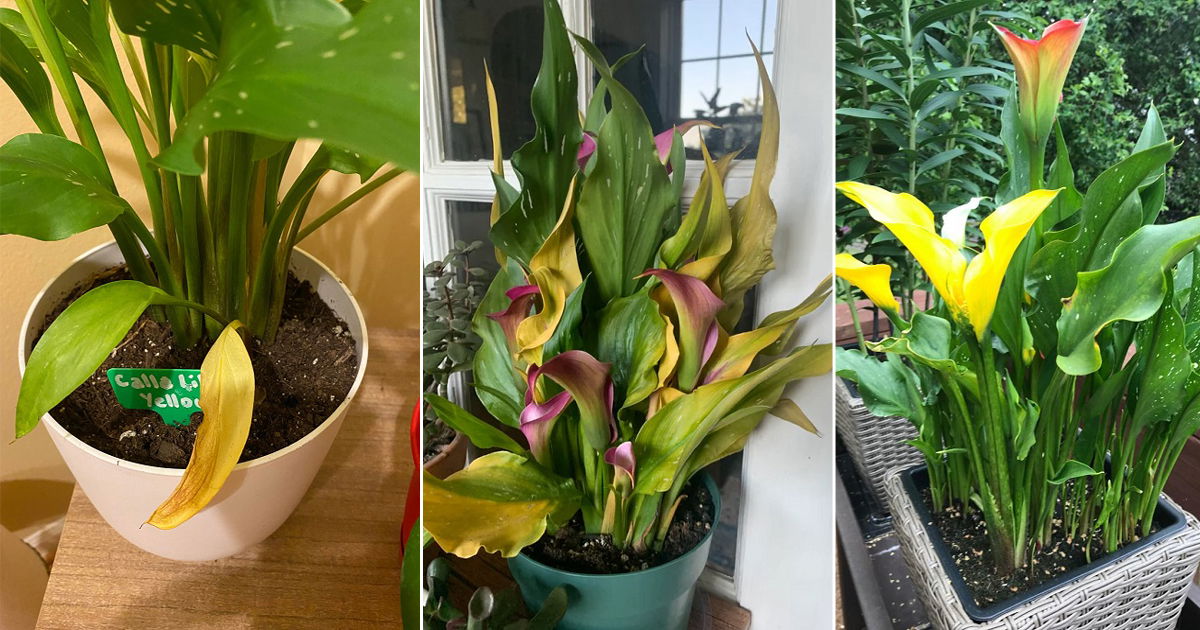Calla lilies are prized for their lush green leaves and elegant white blooms. But when those leaves start turning yellow, it’s cause for concern.
Yellowing leaves are the most common symptom of an underlying issue. With some focused troubleshooting and care adjustments, you can get your calla lily back to good health.
Why Are the Leaves Turning Yellow?
There are a few key reasons why a calla lily’s leaves may turn yellow
-
Overwatering – Too much moisture suffocates the roots and hampers nutrient absorption.
-
Underwatering – Dry soil prevents the roots from taking up nutrients and water.
-
Poor lighting – Too much sunlight scorches the leaves, while too little light causes chlorosis.
-
Nutrient deficiency – Lack of nitrogen, iron zinc, or other nutrients leads to yellowing.
-
Diseases or pests – Fungal, bacterial, or viral infections as well as sap-sucking insects cause yellowing.
-
Cool temperatures – Calla lilies prefer warm conditions between 60-80°F. Cooler temps cause leaf yellowing.
-
Post-bloom decline – It’s normal for foliage to yellow and die back after flowering
Pinpointing the cause is the first step toward treatment.
Fixing Watering Issues
Improper watering causes many problems for calla lilies.
For overwatering:
- Space out watering to allow the soil to partially dry.
- Ensure pots and soil provide good drainage.
- Water less in cool weather when growth is slower.
For underwatering:
- Water whenever the top few inches of soil are dry.
- Soak the soil thoroughly until water drains from the bottom.
- Use soil amendments to improve moisture retention.
Adjusting Light Conditions
- Move plants to a shadier spot if leaves are scorched.
- Provide bright, indirect light if leaves are pale and weak.
- Rotate plants periodically for even sun exposure.
- Filter harsh sunlight with sheer curtains.
Boosting Nutrients
- Test soil to determine specific deficiencies.
- Apply a balanced liquid fertilizer every 2-4 weeks during growth.
- Work controlled-release fertilizer into potting mix for constant nutrients.
- If nitrogen deficient, use a fertilizer higher in nitrogen.
Controlling Pests and Diseases
- Isolate and discard badly infected plants to prevent spreading.
- Remove pests with insecticidal soap, neem oil, or handpicking.
- Improve air circulation and avoid excessive moisture.
- Apply copper fungicide for fungal diseases.
Adjusting Growing Conditions
- Move plants to a warmer spot if possible, avoid drafty areas.
- Group potted plants together to retain warmth.
- Make sure plants get bright, indirect light even in winter.
- Reduce water and fertilizer in cool weather.
Providing Post-Bloom Care
- Remove spent flowers but keep caring for the plant.
- Cut back old flower stalks at soil level after the blooms fade.
- Resume normal watering and fertilizing when new growth appears.
With some focused troubleshooting and care adjustments, you should see your calla lily’s foliage return to a healthy green. Be patient, as it may take a few weeks to rebound depending on the severity of the issues. Proper care will keep your calla lily thriving for years to come.
Calla Lily Leaves Turning Yellow – Common Reasons(with Solution)
FAQ
How to revive a dying calla lily?
How often should you water a calla lily?
How can you tell if a calla lily is overwatered?
How do you know if a calla lily is dying?
You can tell your Calla Lily is dying by the presence of yellowing or wilting leaves, stunted growth, or failure to bloom. These are all potential symptoms of root rot, fungal disease, or other conditions that can harm or kill your plant. In this article, we’ll discuss these and other signs and symptoms of a problem with your Calla Lilies.
Why do calla lily leaves turn yellow?
Below are the potential reasons calla lily leaves may turn yellow: One of the things that you should know about these plants is that they tend to replace their leaves over time. When the leaves of the plant begin to die, they will start turning yellow.
Can you remove yellow leaves from calla lilies?
Absolutely! Removing yellowing leaves from your Calla Lily plants is recommended. Simply trim the affected leaves near the base using clean and sharp pruning shears. This practice helps maintain the health and appearance of the plants. 3. What Is the Ideal Temperature Range for Calla Lilies?
Why are my calla lilies drooping?
Common reasons for underwatering Calla Lilies include insufficient watering, overly large pots, root-bound plants, and hot, dry climates. Signs of insufficient watering in Calla Lilies include: Yellow Leaves: An early indicator of underwatering. Drooping Leaves: Signify a lack of water. Brown or Crispy Leaves: Indicate inadequate moisture.
- A Complete Guide to Caring for Yuki Cherry Blossom Shrub - January 23, 2025
- Identifying Red Hot Poker Seeds: What to Look For When Harvesting Torch Lily Pods - January 23, 2025
- A Complete Guide to Harvesting Evening Primrose Seeds - January 23, 2025

